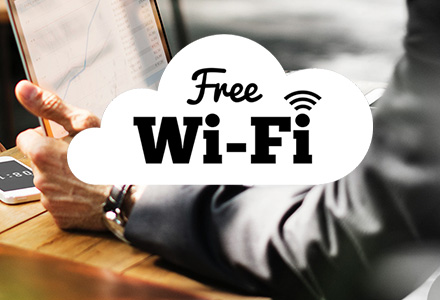Public WiFi Security: 9 Steps to Protect Yourself

Love free public WiFi? The chance to save your phone plan, or maybe just connect the laptop or tablet and get a little work done with good coffee and no distractions – sounds great! Unfortunately, #hackers also love free WiFi, and with instances of #CyberCrime continuing to rise we all must protect ourselves. Even if you do not use free WiFi, you and your device will pass through public and private WiFi signals every day. Everyone should know these 9 steps for public WiFi security – read on, and be sure to share this information with your family and friends to help them stay informed and protected.
Switch off WiFi when you aren’t using it
If you’re in range of a public WiFi network (shopping centres, coffee shops, libraries, public and transport hubs will almost always have them) and not specifically using it – disable the WiFi on your device to be hidden and prevent cybercriminals from snooping.
Turn on your firewall
Both Windows and Mac OS offer basic firewall protection, and while they are not nearly as secure as fully-featured paid solutions, they offer some defence against attackers.
In Windows, go to Control Panel > System and Security > Windows Firewall.
On a Mac go to System Preferences > Security & Privacy > Firewall.
Learn to recognise secured vs. unsecured WiFi
Unsecured WiFi, public or otherwise, should always be avoided. For the highest security, use your mobile data connection or wait until you are able to use a secured network elsewhere.
Secured WiFi requires you to enter some credentials – a username and password provided by the coffee shop or airline or library, perhaps your email or contact details. Some will require you to register for a username.
Remember: the word “secured” does not mean that using it is safe. It is only confirming that the connection between your device and the network is secured.
Be a Smart Browser
Our individual habits are the biggest defence against – or vulnerability to – cyber criminals. Set up 2-Step Authentication wherever it is offered, especially for email, banking, and social media. Take a look at this helpful video from Google about 2-Step Authentication.
Always use strong passwords containing numbers, upper, and lowercase letters. For an easy way to create strong, easy to remember passwords, click here.
Don’t use public WiFi for anything financial
No internet banking, no online shopping. And absolutely no filling out forms of personal data on public WiFi. Use your phone’s data plan if you must make any financial transactions, or complete any form asking for personal data.
Secure websites show HTTPS and the padlock icon in the address bar
Look for the S and the padlock
If you look in the address bar of your Internet browser (where you type a website address like www.anytech365.com, for example), you will see either http:// or https:// at the beginning of the website address. That S means “Secure”. HTTPS is the industry standard protocol for secure communication over the Internet. In plain English, it is the normal way to secure any communications between computers, phones, and other devices talk to each other via the Internet.
Checking that the websites that you visit are using this secure and encrypted protocol; it dramatically reduces the possibility of your personal data being intercepted between you and the website you are visiting. HTTPS sites will also show a small padlock icon in the address bar.
Keep your system and apps updated
Microsoft, Apple, Android, and iOS all receive regular security updates and improvements, and so does the vast majority of software installed on your PC. Almost all software available today will have the option to automatically update itself.
Hackers are constantly trying to find vulnerabilities, and developers constantly update and improve and protect their products against those vulnerabilities.
Make sure your system and apps are set to automatically update, and click “Yes” to install any updates which your operating system, antivirus, other security software, or your Internet browser advises you to install or update.
Turn off file and printer sharing
At home or at work, the ability to share files and printers is useful, and the network should have been secured by a professional already. On a public network, this allows remote logins from other devices in the same network.
In Windows, go to Control Panel > Network and the Internet > Network and Sharing Center. In the left pane, choose Change advanced sharing settings then find the File and Printer Sharing section and select Turn off file and printer sharing.
Use a VPN
A VPN, or Virtual Private Network, creates a nearly-unbreakable and secure connection between your device and the Internet, encrypting all traffic. Using a VPN even at home has many benefits, but in public, it makes you an almost impossible target for hackers. A high quality and secure VPN will usually cost a subscription fee – a worthwhile investment if you value your privacy and protecting your data online.
There you have it – 9 simple steps to public WiFi security. If you would like help with any of these security tips, or if you have any other PC or Internet related problems, concerns, or questions we would love to help give you peace of mind and help resolve any issues. We offer technical support in 13 languages, and we’re ready to help you – click here to get in touch.
IoT Security Solutions from friendly IT experts | AnyTech365

